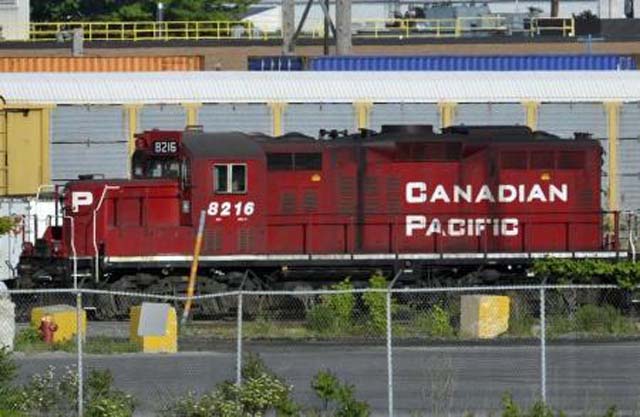|
A Canadian Pacific locomotive rests at the Obico Intermodal Terminal - 23 May 2012 Mike Cassese.
28 October 2014
Smoother Grain Flow Points to Ottawa Lifting Rail Regulations
Ottawa Ontario - Barring a sudden pile-up of grain across Western Canada in the next five weeks, Ottawa will lift requirements that
railways move minimum volumes of crops, Agriculture Minister Gerry Ritz said in an interview.
While Ritz says he is not ruling out any options before the rules expire 29 Nov 2014, government data shows that grain has flowed more smoothly since the
current harvest began compared to a year ago.
The government would need to see "a complete failure by the railways to move grain" to extend the minimums, Ritz told Reuters, citing potential signs
such as grain piling up in elevators and boats waiting to load at ports.
Problems still exist, but not like in early 2014, Ritz said.
A record-large harvest and harsh winter overwhelmed Canadian National and Canadian Pacific last winter, plugging grain elevators in the world's No. 3 wheat
exporter and forcing farmers to store millions of tonnes of crop instead of selling for cash.
Ottawa responded with regulations forcing railways to move about 1 million tonnes per week combined.
"There are some stories out there still that make the hair on the back of my neck stand up," Ritz said.
"But having said that, the order in council did what it was intended to do."
If Ottawa lifts its regulations, it would please fertilizer makers and mills that have complained they are at a disadvantage.
But the Conservative government would risk upsetting farmers heading into an election next year.
Canada exported 3.9 million tonnes of wheat and 1.9 million of canola through ports from 1 Aug 2014 through 19 Oct 2014, up 16 and 41 percent, despite a
smaller harvest this year, according to Canadian Grain Commission data.
"Things are going fairly well," said Mark Hemmes, president of Quorum Corp, who monitors grain movement for Ottawa.
"While grain companies still say they are short on rail capacity, the numbers are better than the five-year average in terms of port
unloads."
Smoother grain movement coincided with the government order in March and milder weather.
CN spotted 5,267 Western Canada grain cars per week on average in September, up 26 percent from a year earlier, although shy of the 5,659 cars that grain
companies ordered, according to company data.
CP moved 25 percent more cars of Canadian grain in the third quarter than in the year-earlier period, spokeswoman Breanne Feigel said.
Even so, there is plenty of grain still to move, Hemmes said.
The Canadian Transportation Agency (CTA) is gathering data to determine how busy the winter shipping season may be.
Its data, along with Quorum's, will go to Ritz and Transport Minister Lisa Raitt, key figures in the government's decision on regulations.
REGULATOR DECISION GAVE SHIPPERS CLOUT
A decision earlier this month by the CTA may also give grain shippers the upper hand in dealing with railways.
It sided with the Canadian unit of global grain trader Louis Dreyfus Corporation that CN breached its contract by failing to provide adequate service,
rejecting the railway's reasons.
"It is a very constructive victory for shippers, and farmers," said Brant Randles, president of Louis Dreyfus' Canadian unit.
Randles said he is not convinced the volume requirements need to be extended due to a smaller harvest this year.
In a statement, CN said Western Canada's key supply chains are back in sync and the railway is moving record volumes of grain.
Canadian Pacific said it wanted to work with stakeholders on improving supply chain efficiency.
EASTERN BUYERS SHORT-CHANGED
To be sure, some want Ritz to keep up the regulatory pressure.
The Western Grain Elevator Association, which represents handlers such as Richardson International and Cargill Ltd., wants volume thresholds to remain at least
through winter.
If the regulations stay in place, eastern Canadian processors say they need to include minimum shipping volumes to Canadian and U.S. mills and separate
minimums for processed products.
To meet volume targets, the railways funneled maximum volumes through big West Coast and Lake Superior ports at the expense of eastern Canadian and U.S.
processors that cannot accommodate large trains, grain buyers said.
Supplies of wheat and oats to those plants dwindled sharply last winter and never fully recovered, creating potential knock-on shortages for food companies
that buy flour, milled oats, and canola oil.
"Rail service continues to be inadequate, uneven, and unpredictable," said Gordon Harrison, president of Canadian National Millers Association, whose
members include Archer Daniels Midland Company.
"If you're going to extend the directive to railways to move minimum volumes, you have to be more surgical about it so that processors' needs are
met," he said.
Rod Nickel.
|

